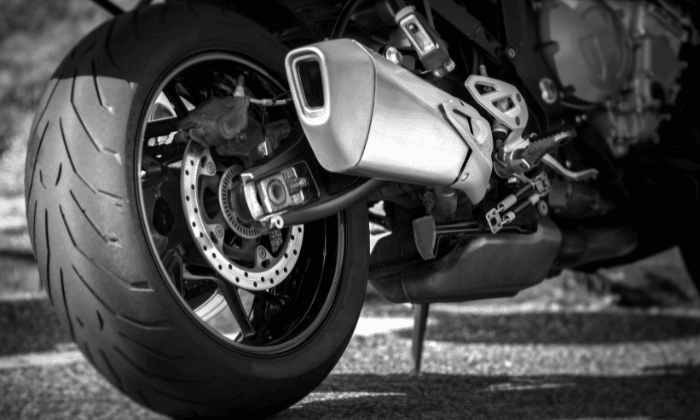Motorcycle Tire Sizes Explained – Meaning & Chart

After miles and miles of riding you will need to replace your tires, and there are a lot of options to choose from when that time comes. There are so many options, ranging from sporty tires designed for maximum grip on the road to knobby dirt tires that are ideal for rough terrain and everything in between. And that doesn’t even begin to cover the brands!
However, the tread pattern and brand don’t mean anything if the tires you choose don’t actually fit your bike. Fortunately, motorcycle tires are labeled so that you know their exact dimensions as long as you know where to look and how to decipher the numbers and letters they use.
In this article, we’ll go into how motorcycle tires are labeled, from size to speed rating! Also if you are one of those Bigger Guys these are the best motorcycles
Table of Contents
How is Motorcycle Tire Sizing Calculated?
Technically speaking, the things you need to measure to figure out the size of a tire are width, height, speed rating, and diameter. The letters denote what kind of speed the tire can handle, and how it is constructed. Let’s take a look at an actual motorcycle tire size.

The Dunlop SportMax RoadSmart III has a size of: 120/70ZR-18
At first glance, these numbers can be a little hard to interpret, but never fear – that’s why you’re here! We’ll start this explanation by breaking down the whole size into the individual components it’s measuring.
[120] measures the tire’s width in millimeters. This measurement is directly related to the next part of the measurement as well as how much of the tire is actually in contact with the road. (More on that later!)
[70] indicates what percentage of the tire’s width makes up its height – this is the Aspect Ratio. In this case the aspect ratio is 70, so 70 percent of the tire’s width makes up its height or 84 millimeters.
[Z] means that this tire’s speed rating is “Z” or the highest speed rating available for motorcycle tires. These tires are capable of handling speeds over 149mph!
[R] tells us that these tires use radial construction. Most newer tires are made this way, but we’ll revisit this in more detail a little later on.
[18] is the diameter of the tire in inches. This tire will fit on an 18-inch rim.
Motorcycle Tire Sizes: How are They Categorized?
The Dunlop we used as an example uses the “Metric” category of sizing, but this is not the only way that tires are sized! There are three major categories of motorcycle tires that you may encounter. While most tires fall into the metric category, some are labeled with an Alphanumeric or a Numeric value instead. Let’s take a look at the different categories:
Metric
This category is the most common and is found on a wide variety of tires across all applications. It begins with the width of the tire in millimeters, followed by the aspect ratio. These two figures will indicate the “contact patch” of the tire – or how much of the tire is in contact with the road at any given time.
A wider tire and lower aspect ratio will increase the size of the contact patch, and generally increase traction as a result, however, this can also have a negative effect on fuel economy.

After the width and aspect ratio, the tire will often have a speed rating. This rating will be a letter that corresponds to the maximum speed in miles per hour that the tire will be able to handle safely.
| J | K | L | M | N | P | Q | R | S | T | U | H | V | W | Y | Z/ZR |
| 62 | 68 | 75 | 81 | 87 | 93 | 99 | 106 | 112 | 118 | 124 | 130 | 149 | 168 | 186 | 149+ |
After the speed rating, a tire labeled in the metric category may have another letter – “B” or “R” – relating to the way it is constructed. “B” stands for “Bias Ply”, an older method of construction that is particularly good at handling heavy loads. You may see this type of construction on tires made specifically for heavy cruiser motorcycles.
“R” refers to radial tires. Radials are more flexible and provide better feedback to the rider. They also dissipate heat far more effectively than bias-ply tires. Due to these advantages, they are very common on sport bike applications, where the tires will be asked to handle higher-stress situations.
The final piece of this size is the diameter of the tire. This is the simplest piece of the label, as it will match the rim the tire is installed on. However, unlike the width and aspect ratio, the diameter is measured in inches rather than millimeters.
Alphanumeric
The alphanumeric category is an older way of measuring motorcycle tire sizes, but one that is very similar to the metric category. With alphanumeric sizing, the size is written with a code that will require the use of a reference chart as well as the diameter of the tire in inches.

The “M” in the alphanumeric value indicates that the tire is meant to be installed on a motorcycle, followed by the width code, which, as explained, you will need to consult a reference chart to find. After the two letters, the next number is the aspect ratio, just like with a metric label, and after that is the diameter.
An alphanumeric label of MT90 17 will be the same size as a 130/90R(or B)17.
You may sometimes still see this category when looking for tires specifically made for cruiser motorcycles or other specialty applications. This category is not particularly common, however, as it is more difficult to read and is no longer the standard category of measurement.
Numeric
The third and final category of tire measurement is the Numeric category. You may see this measurement on tires meant for use with sidecars, classic machines, or even some dirt bikes.
Unlike the previous two categories, which included both numbers and letters to describe the tire, and used metric measurements, the numeric category only uses numbers. It uses inches as its unit of measurement.

A numeric code will be written like this: 5.10 – 16
There are two specific things being measured with this number. First is the width of the tire, 5.10 inches in this case. The second number is the diameter. So in our example, the tire is 5.10 inches wide and 16 inches in diameter. Notice that the aspect ratio is not provided for tires labeled this way, nor is the tire’s speed rating.
In cases where that information is important, or if the specifications for your bike use another category of measurement, you may need to contact the tire manufacturer or an experienced mechanic to convert this size to a more comprehensive one.
You can also check out the Biker’s Rights article on How Long Do Motorcycle Tires Last?
Frequently Asked Questions
How do I know what size motorcycle tires to buy?
There are two ways to find the correct size of tires for your bike. First, you could consult the owner’s manual and check the measurements that way. If you prefer a more direct approach, you can also get on the ground and check the measurement of the original tire while it is still installed. The label is found on the sidewall.
Is a wider tire better on a motorcycle?
Fitting a wider rim and tire to your bike is a trade-off. As mentioned earlier, a wider tire with a lower aspect ratio will have more contact with the road. Maximizing the size of the contact patch means that the tire will have better overall traction, improving the performance of the bike.
However, there are two things to consider. Wider tires can have a negative impact on the bike’s fuel economy. If you want to maximize your MPG, then sticking with factory specs is a better option. In addition, a lower profile tire does not absorb the bumps and imperfections in the road surface very well and can be uncomfortable, especially on longer rides.
Whether it is “better” to go wider depends entirely on whether you find these tradeoffs acceptable or not.
Do the front and rear tires need to match on a motorcycle?
It is actually very uncommon to find a motorcycle with front and rear tires the same size! Typically the rear tire will be wider than the front to allow more traction for acceleration. This can be subtle, like the difference seen in most street bikes, or outrageous – as might be found on drag racing bikes or customized cruisers.
Conclusion
Here, we’ve taken a look at tires, how they are measured, and how some of these measurements can affect the overall riding experience. Your tires are an important part of your bike and affect everything from performance to safety. Making an educated decision on what sort of tire to have installed on your bike is key to ensuring that you can continue enjoying the ride for many more years.
Now that you know how to read tire measurements, you will know exactly what all the letters and numbers mean when you’re browsing for your bike’s next set of rubber.
